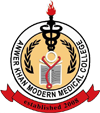Anwer Khan Modern Medical College
Library Management System

| Title: | Hutchison's clinical methods: an integrated approach to clinical practice |
| Author Name: | Michael Glynn and William M. Drake [Editor]. |
| Author Sur Name: | GLYNN, Michael. |
| Author information: |
|
| Edition/Published: | 23rd ed. _London : Elsevier , 2012 |
| New to this edition: |
|
|
Physical Description: xii, 472p., : ill. (some col.), tables.; 26.5cm. |
| Notes | Includes Index. |
| Includes Index: | P. 453-472 |
| ISBN No's: | 978-0-7020-4092-4 |
| Bar Code's: | |
| Shelf Location's: | 38 |
| Classification | |
| Subject: | Diagnostic Techniques and Procedures |
| Dewey Class No: | 616.07/5 |
| Letter Call No: | GL52h |
| LC Classification: | RC46 .H89 2012 |
| Other's Book Information | |
| Book ID No: | 2007 |
| Total Books: | 1 |
| Date of collection's: | 21-Oct-2025 |
| Donation / Purchase: | Purchase |
| Language: | English |
| Status: | Available |
| Department: | Medicine |
| Synopsis: |
|
| Review: |
|
| Description: |
|
| Key Features: |
|
| Summary: |
|
| Abstract: |
|
| Preface: |
|
| Content: |
SECTION 1 HISTORY TAKING AND GENERAL EXAMINATION 1 Approach to the patient 1 Colin Robertson, Fiona Nicol, Graham Douglas 2 History taking 5 David Snadden, Robert Laing, Stephen Potts, Fiona Nicol, Nicki Colledge 3 The general examination . . . . . . . . . . . . . . 41 Graham Douglas, John Bevan SECTION 2 SYSTEM EXAMINATION 4 The skin, hair and nails 63 David Gawkrodger 5 The endocrine system . . . . . . . . . . . . . . . 77 John Bevan 6 The cardiovascular system . . . . . . . . . . . . 97 Neil Grubb, James Spratt, Andrew Bradbury 7 The respiratory system 137 Graham Devereux, Graham Douglas 8 The gastrointestinal system 165 Alastair MacGilchrist, John Iredale, Rowan Parks 9 The renal system 195 Allan Cumming, Stephen Payne 10 The reproductive system . . . . . . . . . . . . .211 Elaine Anderson, Colin Duncan, Jane Norman, Stephen Payne 11 The nervous system . . . . . . . . . . . . . . .239 Richard Davenport, Hadi Manji 12 The visual system . . . . . . . . . . . . . . . 275 John Olson, Rebecca Ford 13 The ear, nose and throat . . . . . . . . . . . 297 Janet Wilson, Fiona Nicol 14 The musculoskeletal system . . . . . . . . . 315 Jane Gibson, James Huntley SECTION 3 EXAMINATION IN SPECIFIC SITUATIONS 15 Babies and children - - - - - - - - - - - - - - - - - --355 Ben Stenson, Steve Turner 16 The frail elderly 379 Andrew Elder, Elizabeth MacDonald 17 The febrile adult . . . . . . . . . . . . . . . 391 Dilip Nathwani, Kum Ying Tham 18 Assessment for anaesthesia and sedation . 401 Laura Robertson, Andrew Longmate 19 The critically ill . . . . . . . . . . . . . . . .411 Gareth Clegg, Colin Robertson 20 Confirming death . . . . . . . . . . . . . . 423 Jamie Douglas, Graham Douglas SECTION 4 ASSESSING CLINICAL EXAMINATION TECHNIQUE 21 OSCEs and other examination formats . . . 427 Paul O’Neill Index . . . . . . . . . . . . . . . . . . . . . . 441 |
Related Books
- Davidson's principles and practice of medicine.
- Macleod's clinical examination
- Hutchison's clinical methods: an integrated approach to clinical practice
- Hutchison's clinical methods: an integrated approach to clinical practice.
- Davidson’s principles and practice of medicine.
- Davidson's principles and practice of medicine
- Rapid review of, clinical medicine
- Morgan & Mikhail's clinical anesthesiology.
- Talley & O'Connor's clinical examination : a systematic guide to physical diagnosis
- Macleod's clinical examination
